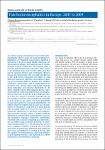Tick-borne encephalitis in Europe, 2007 to 2009
Mantke, Oliver Donoso
Escadafal, Camille
Niedrig, Matthias
Pfeffer, M.
As a follow-up of a retrospective survey on tick borneencephalitis (TBE) in 2008, the European Network for Diagnostics of “Imported” Viral Diseases launched a new survey in 2010, to collect broader information on TBE prevalence between 2007 and 2009 and to observe possible changes compared to the previous data. A two-part questionnaire was mailed to contact points in all European Union (EU) Member States and four non-EU countries (Bosnia and Herzegovina, Norway, Russia, and Switzerland). The first part was identical to the 2008 survey, requesting information on case definition, diagnostic methods, investigations regarding tick-transmitted diseases, endemic foci mapping, vaccination programmes, and recommendations for travellers. The second newly added part, inquired about geographic and seasonal distribution of TBE cases, imported cases, TBE subtypes, animal cases, and prevalence in ticks and wildlife hosts. Of 28 participat- ing countries, 16 had TBE as a notifiable disease, as in the first survey. In the 2007–2009 period, the total number of notified cases (17,818) was lower than in 2004–2006 (21,339 cases), also when subtracting Russian cases (8,207 vs 9,073 cases respectively). The highest reported incidence was 18.5 per 100,000 population in Lithuania in 2009. The 2010 study showed that increased numbers of countries used PCR and nucleotide sequencing for particular investigations. Most countries, however, relied on specific antibody detection by enzyme linked immunosorbent assay for TBE laboratory diagnosis. Disparities nevertheless remained across countries regarding case definitions, and surveillance and prevention activities. To understand changing patterns in TBE transmission, surveillance strategies including screening of vector ticks and testing of animal hosts should be harmonised and done more systematically in Europe. Collected data will support rec-ommendations concerning diagnostic and mapping methods, case reporting, vaccination programmes and information campaigns.
No license information

